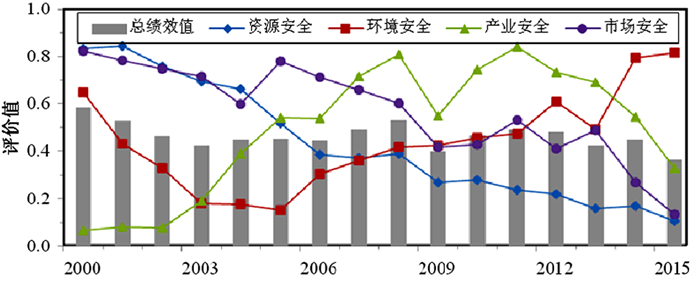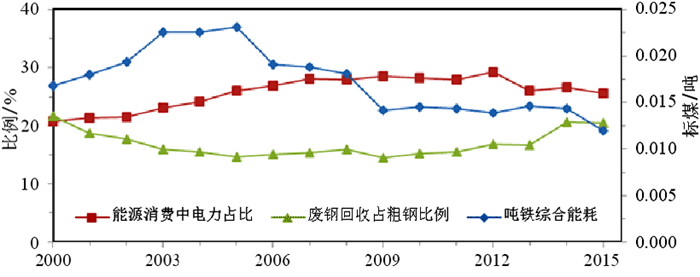Safety Evaluation of Iron Ore in China Based on Entropy Weight Method
-
摘要:
从资源、产业、环境、市场四个维度出发,建立了中国铁矿石安全综合评价指标体系,采用熵权法对2000-2015年中国铁矿石安全状况进行定量评价。资源安全和市场安全指数在21世纪初期整体呈下降趋势;产业安全指数对铁矿石的安全的影响起初较小,后快速上升;环境安全程度在2005年以前快速降低,之后逐渐升高;铁矿石的安全状况在资源安全、环境安全、产业安全、市场安全的综合作用下,2000-2009年,铁矿石安全综合指数呈波动下降的趋势;2009-2015年,铁矿石安全综合指数在波动中略有上升,但仍处于临界不安全状态。为提高中国铁矿石的供应安全,不仅要强化勘探开发、节约和再生铁矿资源以增强本国资源供应能力,还应加强合作,强化全球矿产资源布局。
Abstract:Based on the four dimensions of resource, industry, environment and market, this paper established the comprehensive evaluation index system of iron ore in China, and integrated the entropy weight method and technique for order preference by similarity to an ideal solution (TOPSIS)method to quantitatively evaluate the safety situation of iron ore in China from 2000 to 2015. Resource security index and market safety index showed downward trends as a whole during the studied period. The impact of industrial safety index on the safety of iron ore was initially small and then increased rapidly. The environmental safety index declined rapidly before the year 2005 and was followed by a positive impact on the safety of iron ore. The comprehensive security situation of iron ore showed a downward trend in 2000-2009 while increased slightly in the volatility in 2009-2015, but still in a critical state of insecurity. To guarantee the safety situation of iron ore in China, the domestic iron ore supply must be improved by intensifying geological exploration and saving resources, and the international cooperation and global resources layout should also be intensified.
-
Key words:
- China /
- iron ore /
- safety evaluation /
- entropy weight method
-

-
表 1 矿产资源安全评价值判断标准[32]
Table 1. Evaluation standard for the safety evaluation of mineral resources
极端不安全 严重不安全 中度不安全 轻度不安全 濒临不安全 0~0.09 0.10~0.19 0.20~0.29 0.30~0.39 0.40~0.49 勉强安全 初级安全 中级安全 良好安全 优质安全 0.50~0.59 0.60~0.69 0.70~0.79 0.80~0.89 0.90~1.00 表 2 熵权法各指标权重表
Table 2. The index weights for safety evaluation based on entropy weight method
总目标 第一指标层 第二指标层 总权重 指标 权重 指标 权重 铁矿石安全评价 储采比 0.531 3 0.182 6 资源安全 0.343 6 单位GDP铁矿石消费量 0.181 9 0.062 5 人均铁矿石消费量 0.286 7 0.098 5 吨铁综合能耗 0.257 7 0.071 9 环境安全 0.279 2 能源消费中电力占比 0.238 1 0.066 5 废钢回收占粗钢比例 0.504 3 0.140 8 本国资源生产能力 0.226 6 0.057 5 产业安全 0.253 6 营业利润率 0.336 7 0.085 4 劳动生产率 0.436 7 0.110 7 铁矿石价格 0.252 3 0.031 2 市场安全 0.123 7 主要进口国控制度 0.320 9 0.039 7 对外依存度 0.426 8 0.052 8 表 3 各年度评价值表
Table 3. The list of values for safety evaluation
年份 资源安全 环境安全 产业安全 市场安全 总绩效值 2000 0.833 6 0.649 8 0.063 6 0.825 2 0.586 1 2001 0.846 2 0.433 1 0.080 9 0.782 8 0.529 1 2002 0.757 9 0.327 3 0.074 5 0.748 6 0.463 3 2003 0.695 5 0.177 6 0.189 0 0.717 6 0.425 3 2004 0.665 2 0.174 9 0.389 5 0.600 1 0.450 4 2005 0.517 7 0.150 5 0.543 7 0.781 3 0.454 5 2006 0.387 3 0.305 0 0.540 5 0.713 5 0.444 8 2007 0.372 3 0.360 7 0.715 9 0.659 0 0.491 7 2008 0.389 8 0.417 6 0.809 6 0.602 3 0.530 3 2009 0.267 2 0.424 3 0.548 8 0.418 0 0.401 1 2010 0.280 5 0.457 6 0.744 6 0.427 7 0.465 9 2011 0.235 8 0.475 0 0.843 0 0.533 4 0.493 4 2012 0.217 9 0.610 0 0.736 1 0.410 7 0.482 6 2013 0.158 3 0.494 0 0.690 5 0.488 5 0.426 2 2014 0.167 1 0.794 6 0.545 1 0.267 1 0.450 5 2015 0.104 7 0.817 4 0.328 9 0.132 3 0.363 9 -
[1] 钱鸣高, 刘听成.矿山压力及其控制[M].北京:煤炭工业出版社, 1992.
[2] Main B W, Risk Assessment. A review of the fundamental principles[J]. Professional safety, 2004, 49(12):37-47. http://d.old.wanfangdata.com.cn/OAPaper/oai_doaj-articles_a2f913f11d40ac7a1e083e83f5192a4b
[3] Sovacool B K, Valentine S V, Bambawale M J, et al. Exploring propositions about perceptions of energy security:an international survey[J]. Environmental science & policy, 2012, 16(16):44-64. https://www.sciencedirect.com/science/article/pii/S1462901111001699?via%3Dihub
[4] Bambawale M J, Sovacool B K. India's energy security:a sample of business, government, civil society and university perspectives[J]. Energy policy, 2011, 39(3):1254-1264. doi: 10.1016/j.enpol.2010.11.053
[5] Sovacool B K. Seven suppositions about energy security in the United States[J]. Journal of cleaner production, 2011, 19(11):1147-1157. doi: 10.1016/j.jclepro.2011.03.014
[6] Sovacool B K, Mukherjee I. Conceptualizing and measuring energy security:a synthesized approach[J]. Energy, 2011, 36(8):5343-5355. doi: 10.1016/j.energy.2011.06.043
[7] Wu G, Liu L C, Han Z Y, et al. Climate protection and China's energy security:win-win or trade off[J]. Applied energy, 2012, 97(97):157-163. http://d.old.wanfangdata.com.cn/NSTLHY/NSTL_HYCC0214011663/
[8] Martchamadol J, Kumar S. Thailand's energy security indicators[J]. Renewable & sustainable energy reviews, 2012, 16(8):6103-6122. http://d.old.wanfangdata.com.cn/NSTLQK/NSTL_QKJJ0228346335/
[9] Cohen G, Joutz F, Loungani P. Measuring energy security:trends in the diversification of oil and natural gas supplies[J]. Energy policy, 2011, 39(9):4860-4869. doi: 10.1016/j.enpol.2011.06.034
[10] Löschel A, Moslener U, Rübbelke D T G. Indicators of energy security in industrialised countries[J]. Energy policy, 2010, 38(4):1665-1671. doi: 10.1016/j.enpol.2009.03.061
[11] Coq C L, Paltseva E. Measuring the security of external energy supply in the European Union[J]. Energy policy, 2008, 37(11):4474-4481. https://econpapers.repec.org/article/eeeenepol/v_3a37_3ay_3a2009_3ai_3a11_3ap_3a4474-4481.htm
[12] Cabalu H. Indicators of security of natural gas supply in Asia[J]. Energy policy, 2010, 38(1):218-225. doi: 10.1016/j.enpol.2009.09.008
[13] Sovacool B K. Assessing energy security performance in the Asia Pacific, 1990-2010[J]. Renewable & sustainable energy reviews, 2013, 17:228-247. https://econpapers.repec.org/article/eeerensus/v_3a17_3ay_3a2013_3ai_3ac_3ap_3a228-247.htm
[14] 张华林, 刘刚.我国石油安全评价指标体系初探[J].国际石油经济, 2005, 13(5):44-48. doi: 10.3969/j.issn.1004-7298.2005.05.011
[15] 王楠.对当前我国石油安全的评价和建议[J].长春大学学报, 2008, 18(11):1-5. http://d.old.wanfangdata.com.cn/Periodical/ccdxxb-shkxb200806001
[16] 房树琼, 杨保安, 余垠.国家能源安全评价指标体系之构建[J].中国国情国力, 2008(3):32-36. doi: 10.3969/j.issn.1004-2008.2008.03.011
[17] 胡小平.矿产资源供应安全评价[J].中国国土资源经济, 2005, 18(7):6-8. doi: 10.3969/j.issn.1672-6995.2005.07.003
[18] 王默玉, 魏佳, 申晓留.基于AHP的北京市能源安全研究与分析[J].应用能源技术, 2010(9):7-11. doi: 10.3969/j.issn.1009-3230.2010.09.002
[19] 王晓宇.中国天然气供应安全评价及对策[J].中国石油大学学报(社会科学版), 2015(1):6-10. http://d.old.wanfangdata.com.cn/Periodical/sydxxb-shkx201501002
[20] Gul M, Guneri A F. A fuzzy multi criteria risk assessment based on decision matrix technique:a case study for aluminum industry[J]. Journal of loss prevention in the process industries, 2016, 40:89-100. doi: 10.1016/j.jlp.2015.11.023
[21] Wang C, Zuo L S, Hu P J, et al. Evaluation and simulation analysis of China's copper security evolution trajectory[J]. Transactions of nonferrous metals society of China, 2013, 23(8):2465-2474. doi: 10.1016/S1003-6326(13)62756-9
[22] Hou Y B, Yang J. Application of rough fuzzy neural network in iron ore import risk early-warning[M]. Berlin Heidelberg:Advances in neural networks-ISNN 2010, 2010:432-438.
[23] 刘璇, 陈其慎, 张艳飞, 等.中国铬需求预测及资源供应安全态势分析[J].资源科学, 2015, 37(5):933-943. http://d.old.wanfangdata.com.cn/Periodical/zykx201505010
[24] 李颖, 陈其慎, 柳群义, 等.中国海外矿产资源供应安全评价与形势分析[J].资源科学, 2015, 37(5):900-907. http://d.old.wanfangdata.com.cn/Periodical/zykx201505006
[25] 代涛, 沈镭.我国大宗性矿产资源安全分析与评价[J].矿业研究与开发, 2009, 29(5):97-101. http://www.wanfangdata.com.cn/details/detail.do?_type=perio&id=QK200902605282
[26] 永学艳, 陈建宏.基于AHP的矿产资源安全评价研究[J].有色冶金设计与研究, 2010, 31(5):1-4. doi: 10.3969/j.issn.1004-4345.2010.05.001
[27] 孙永波, 汪云甲.矿产资源安全评价指标体系与方法研究[J].中国矿业, 2005, 14(4):36-37. doi: 10.3969/j.issn.1004-4051.2005.04.011
[28] 赵振智, 刘宏江.基于模糊综合分析法的我国石油储备安全评价体系探析[J].价值工程, 2012, 31(28):95-96. doi: 10.3969/j.issn.1006-4311.2012.28.047
[29] 刘贤信.基于SPSS的我国铁矿石供应安全评价[J].金属矿山, 2010, 39(10):34-37. http://d.old.wanfangdata.com.cn/Periodical/jsks201010010
[30] 范凤岩, 刘冲昊, 柳群义.海外矿产资源投资优选评价[J].矿产保护与利用, 2018(1):17-23. http://kcbh.cbpt.cnki.net/WKD/WebPublication/paperDigest.aspx?paperID=9d27131a-0b8f-4dac-b49c-f36b1bdfbb5f
[31] 俞立平, 张晓东.基于熵权TOPSIS的地区高校科技竞争力评价研究[J].情报杂志, 2013(11):181-186. doi: 10.3969/j.issn.1002-1965.2013.11.035
[32] 束月月, 盖美, 耿雅冬.基于可变模糊识别模型的辽宁省水资源安全评价研究[J].资源开发与市场, 2013, 29(1):20-23. doi: 10.3969/j.issn.1005-8141.2013.01.005
[33] 范振林.中国铁矿资源保障程度研究[J].矿业研究与开发, 2013(6):124-126. http://d.old.wanfangdata.com.cn/Periodical/dqxb200903013
[34] Liu C H, Liu Q Y, Li J W, et al. China's belt and road initiative in support of the resourcing future generations program[J]. Natural resources research, 2018, 27(2):257-274. doi: 10.1007/s11053-017-9342-7
[35] 国务院办公厅.国务院办公厅关于积极推进供应链创新与应用的指导意见[EB/OL].(2017-10-13)[2018-02-21]. http://www.gov.cn/zhengce/content/2017-10/13/content_5231524.htm.
-




 下载:
下载:




